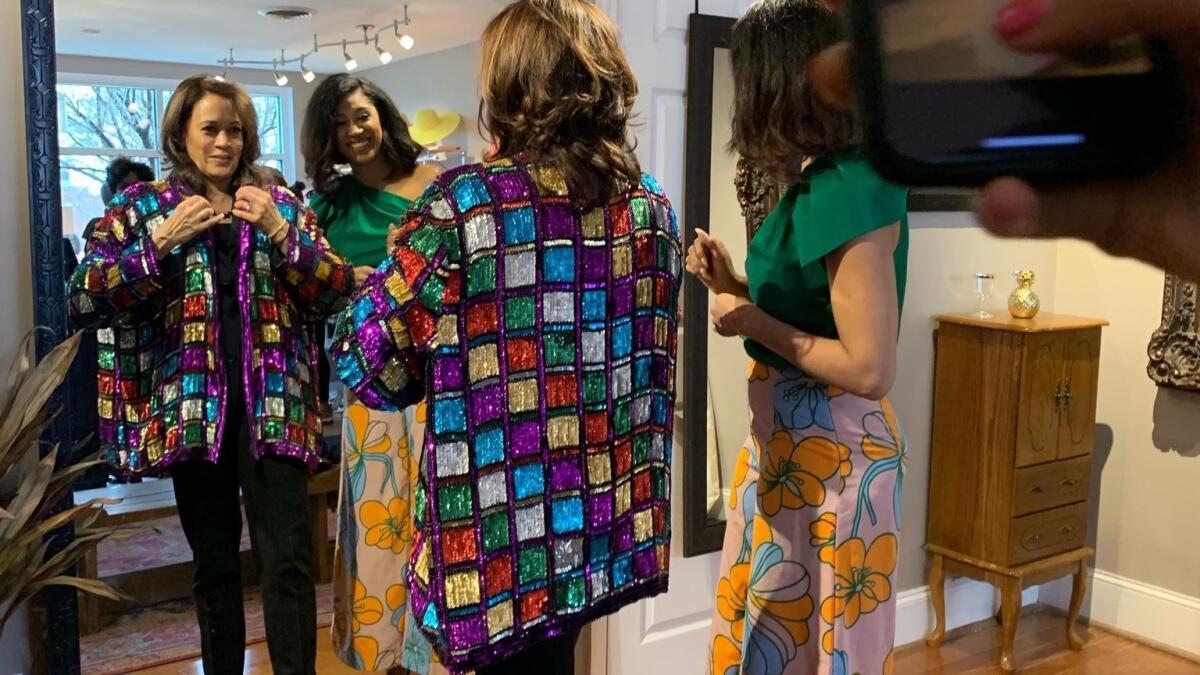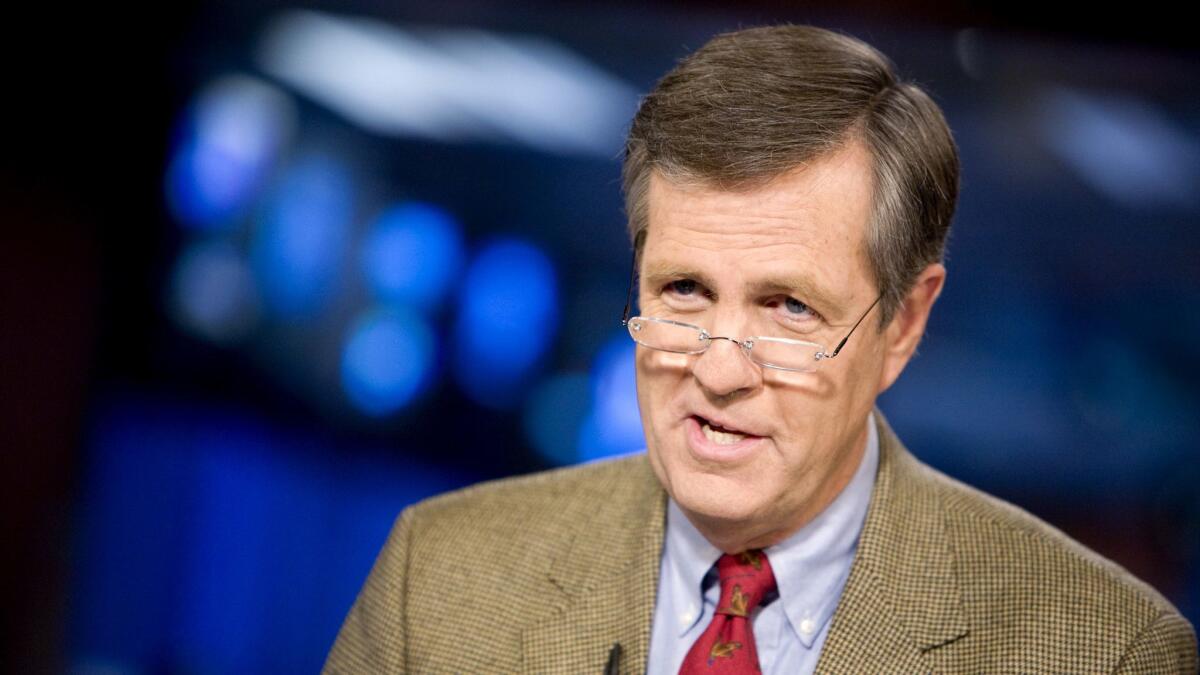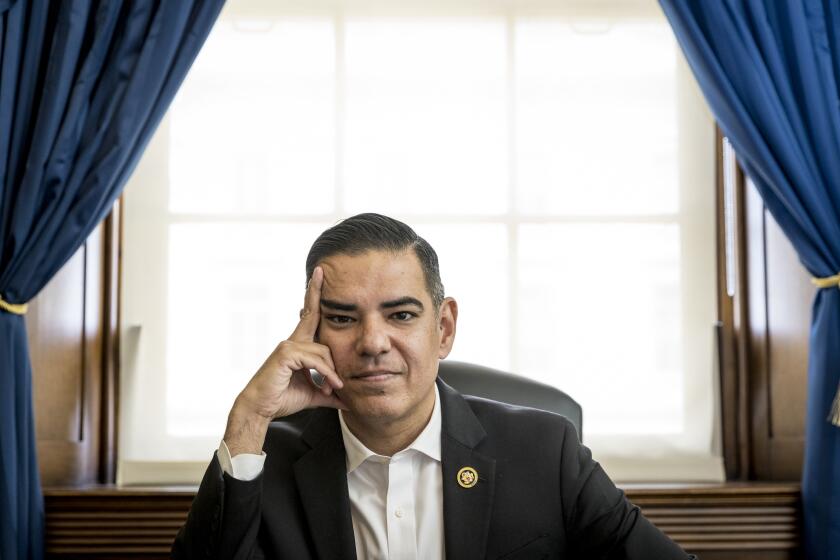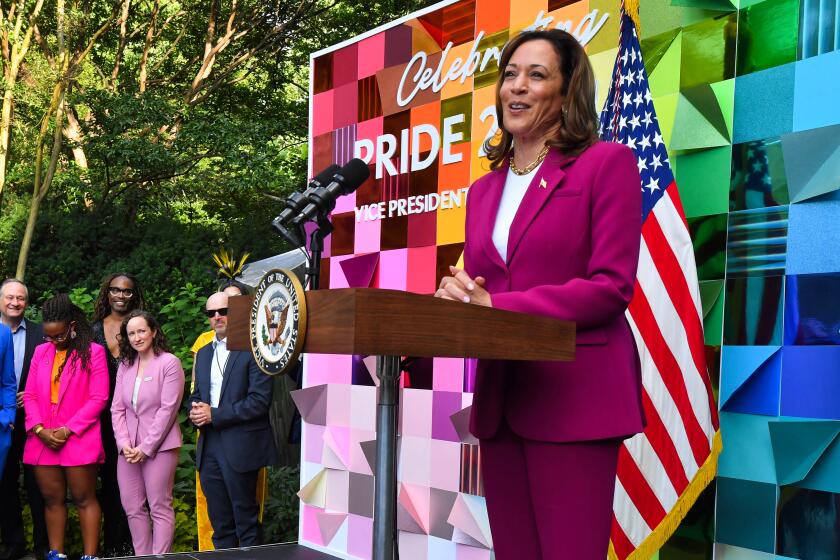Column: On the campaign trail, Kamala Harris tries on a sequined jacket, and men go nuts

Every four years, aspiring presidential nominees leave behind families, jobs and, frequently, their dignity to prove they are worthy of the votes of everyday people.
Senators, governors, million- or billionaires, they traipse through cornfields in Iowa, eat barbecue in South Carolina, get sand between their toes at clambakes in New Hampshire, all in the pursuit of showing they are human beings too.
If you’ve been paying attention, you’ve probably noticed that this peculiar feature of American political life has already begun.
It’s called retail politicking, and sometimes the tradition literally involves retail locations: drugstores, bookstores, gift stores. Or, in the recent case of Democratic presidential hopeful Kamala Harris, a clothing store on Lady Street in Columbia, S.C.
There, after some reporters pointed out a loud jacket, the U.S. senator from California tried it on. It was a vintage sequined thing with shoulder pads that screamed “I’m from the ’80’s!” Ever the Bay Area pol, she joked that its rainbow colors made it perfect for Pride Week.
And then, unfortunately, she bought it.The political reporters covering Harris’ South Carolina visit tweeted videos and photos of her as she preened in front of a mirror wearing the coat. It was a spontaneous campaign-trail moment, unexpected and a little bit playful. It just so happened that the reporters who witnessed the moment were women, and that they happened to be watching a woman — a presumed presidential front-runner — doing something a lot of women love to do.
It was too much for Very Serious Journalist Brit Hume.
“This is just embarrassing,” tweeted the Fox News anchor. “So now journalists are going shopping with Harris, helping pick out clothes and then putting out glowing tweets about it.”
James Taranto of the Wall Street Journal chimed in: “This is a CBS reporter noting, without evident disapproval, that a CNN colleague is helping dress a Democratic candidate she’s supposed to be covering.”
David Martosko of the Daily Mail added: “If this is what the 2020 campaign is going to be like, President Trump’s complaints about the media could have even more staying power with his base than the last time around.”
Come on now, fellas. This is the kind of clueless sexism that we can expect to see repeated through the 2020 campaign cycle, particularly as there are so many women running.
When it came to Hume’s arrogant tweet, it wasn’t just his sexism on display.
It was also his hypocrisy, and the pernicious double standard that finds virtue in “manly” pursuits such as hunting and skydiving and triviality in “female” pursuits such as shopping.
In 2015, a bunch of political reporters, including MSNBC’s Kasie Hunt and the New York Times’ Ashley Parker, went trap shooting with then-aspiring presidential candidate Lindsey Graham, a Republican senator from South Carolina.
Parker, who is now with the Washington Post, wrote that she was glad for the diversion. “After all, in a world in which politicians are increasingly poll-tested and scripted, it was revealing — not to mention refreshing and fun — to spend a freewheeling morning with a man who hopes to become the next president of the United States.”
No one accused those reporters of getting too cozy with Graham.

Likewise, in 2004, Hume went skydiving with former President George H.W. Bush to celebrate his 80th birthday. Afterward, Hume touted his “exclusive” interview with Bush. At the time, you will recall, President George W. Bush was running for reelection. Skydiving with Dad was a blatant publicity stunt for Hume’s network, and almost forgivable.
But when the Very Serious Journalist sat down for his interview, he whiffed: “Do you think the criticism of your son has been harsher and more unfair than you felt the criticism was of you?”
Oh Brit, that was just embarrassing.
::
On the campaign trail, weird symbiotic relationships develop between reporters and the campaigns.
Media critics have used these moments to accuse reporters of going native, that is, of protecting or cozying up to a candidate to maintain access.
Mostly, this is an unfair criticism. No reporter wants to be thought of as soft or co-opted. But sometimes, you get caught up in the insanity of spending long hours, days and weeks with a small group of people with adversarial interests who are traveling together in a highly charged environment.
Small details — like what a candidate ate for lunch — become ridiculously important. (After all, you never know when such data will provoke a major incident, as when then-presidential candidate John Kerry ordered the wrong kind of fromage on his cheesesteak in Philadelphia.)
New York Times reporter Amy Chozick devoted a substantial portion of her brutally honest best-seller “Chasing Hillary” to the warped relationship she developed with Clinton’s handlers — men, mostly — who would freeze her out, berate her or tell her no one respected her work if they didn’t like one of her stories.
Those tensions were never apparent in her coverage.
::
Between now and November 2020, there will be countless unscripted moments on the campaign trail.
Candidates will be out wooing voters, dragging behind them packs of reporters desperate for anything that smacks of unrehearsed humanity.
You cannot attack a reporter for telling you what she’s observing. Nor can you take one campaign trail anecdote out of context, as Hume did, and pretend that this is the totality of the candidate’s news coverage. If the candidate tromps through a pumpkin field in southern Wisconsin with his wife and kids on Halloween, that’s what you write about. (I did, with then-Republican vice presidential candidate Paul Ryan.)
If the candidate roams through the Iowa State Fair eating pork chops on a stick (they all do at some point), you follow. (In 2011, I chased after former Alaska Gov. Sarah Palin, who was deciding whether to run in 2012, and watched her order deep-fried butter on a stick. Everything she ate that day seemed like a calculated rebuke of then-First Lady Michelle Obama’s campaign for healthful childhood eating.)
Trail reporters don’t follow candidates around because they expect to have nuanced discussions about policy, although that occasionally happens.
They are out with candidates to make sure their readers and viewers know what would-be presidents are saying, or promising. To make sure that if a candidate breaks news, they catch it. To get a response to an important news event.
You want to be there when a vice presidential candidate tests a new attack line accusing her running mate’s opponent of “palling around with terrorists.”
You want to be there when a candidate says he’s visited “all 57 states,” — not because it means the candidate is stupid but because it’s a measure of his fatigue.
And maybe you want to be there when a serious presidential candidate who happens to be a woman tries on a colorful coat, and uses the moment to slyly acknowledge LGBT rights. Or is that just too trivial compared to trap shooting and skydiving?
Twitter: @AbcarianLAT
More to Read
Get the L.A. Times Politics newsletter
Deeply reported insights into legislation, politics and policy from Sacramento, Washington and beyond. In your inbox three times per week.
You may occasionally receive promotional content from the Los Angeles Times.











